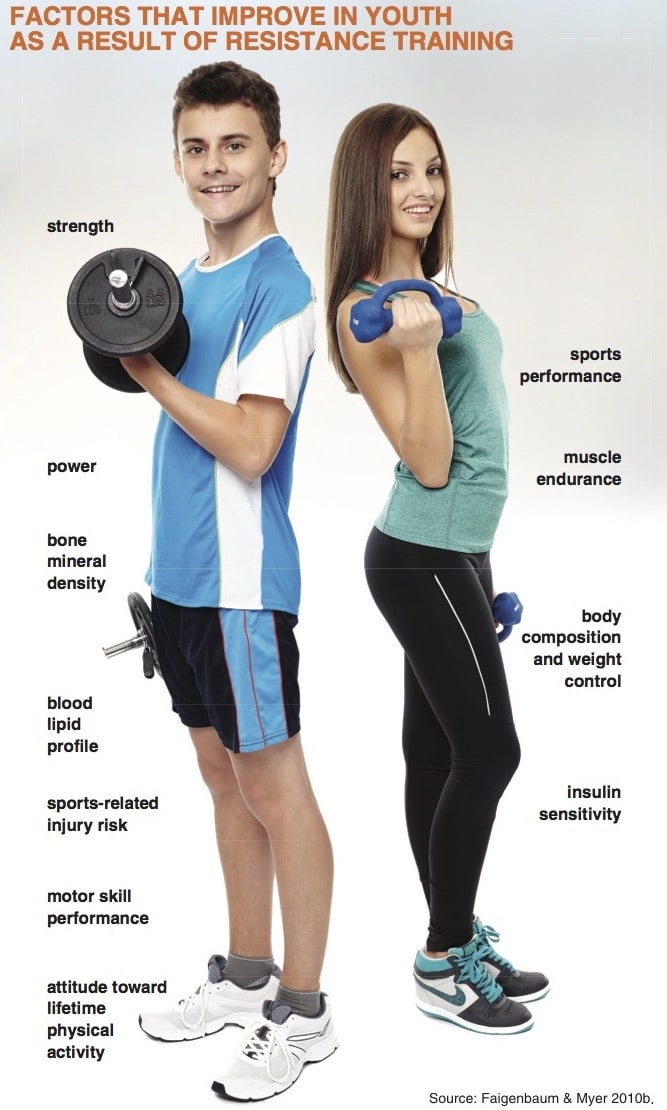Resistance Training for Youth: 10 Tips for Success
There's no reason to avoid resistance training with your young clients. You just have to take some sensible precautions.

Resistance training for youth can be a polarizing topic, mostly because of misconceptions about safety, injury rates and training techniques. Though parents and trainers alike often worry about the hazards of youth resistance training, research shows that it has a host of benefits—if it’s done properly.
As one study concluded, “Current research indicates that resistance training can be a safe, effective and worthwhile activity for children and adolescents provided that qualified professionals supervise all training sessions and provide age-appropriate instruction on proper lifting procedures and safe training guidelines” (Faigenbaum & Myer 2010a). This month, we’ll provide a concise update on resistance training for youth and give 10 practical tips for trainers working with this population.
Defining Resistance Training for Youth
Resistance training for youth requires a specialized program using a broad range of resistance loads, movement velocities, and exercise modalities such as machines, free weights, bands, plyometrics and medicine balls. It does not include bodybuilding, which aims to develop definition, size and symmetry, or powerlifting and other weightlifting sports that use near-maximal loads (Faigenbaum & Myer 2010a).
Safety Data on Resistance Training for Youth
In their literature review, Faigenbaum & Myer (2010a) summarize research showing that resistance training is safe and effective for children and adolescents who follow age-appropriate guidelines. Programs can use single- and multiset training protocols on a variety of equipment, and these programs produce significant strength gains in youth, according to the data. Furthermore, maximal-strength testing has been found to be safe for healthy boys and girls following guidelines established by qualified professionals.
Faigenbaum & Myer (2010a) note that in some recreational activities and sports (e.g., running, rugby and gymnastics), young people encounter much stronger, more sustained forces than they do in maximal strength tests. Importantly, injury to growth cartilage has not been reported in any youth training study that provided appropriate instruction. There can be a risk of growth-plate injury, but it’s much higher in competitive sports where jumping and landing activities produce ground reaction forces 5–7 times body mass (Faigenbaum & Myer 2010a).
When concerned parents ask if weight training is safe and appropriate for youth, personal trainers should reply that it carries some degree of inherent risk for musculoskeletal injury, but the threat is no higher than it is from other youth sports and recreational activities.
Resistance Training for Youth: 10 Evidence-Based Strategies
Two comprehensive literature reviews provide broad guidelines for personal trainers (Faigenbaum & Myer 2010a, 2010b). Here are 10 key principles:
- Assess your clients’ readiness: Young people beginning resistance training must demonstrate the maturity to accept coaching directions consistently and responsibly.
- Ensure that young clients always wear appropriate resistance training clothing that does not restrict movement. Proper athletic footwear, with good foot and ankle support, will safeguard support and traction.
- Begin resistance training sessions with a dynamic warmup. Be sure to include multiplanar exercises that enhance range of motion, balance and overall kinesthetics (sense of body position in motion). Examples: skipping, single-leg balances, hopping and unilateral/bilateral jumping. Sessions should offer exercises for the major muscle groups of the body, including the core musculature.
- Get creative with your programming. No single combination of exercises, sets and repetitions has emerged as superior for muscular adaptation in youth. The literature suggests that multifaceted training combinations do the best job of enhancing movement mechanics, functional abilities and muscular strength. Systematically varying the training program minimizes the potential for overtraining and sports-related injuries. For instance, blending medicine ball exercises with traditional resistance training works well. Also, including high-intensity intermittent activities—sprints, jumps and medicine ball throws—improves many components of fitness while preventing training boredom.
- If possible, start preparatory resistance training before your young clients play competitive sports. If they are already playing sports, find out how many they play and how much they practice. Then carefully measure how much resistance training you can add without contributing to chronic repetitive stress on the developing musculoskeletal body.
- Emphasize proper exercise technique in sessions. You can initiate progressive overload after a client demonstrates proper lifting mechanics.
- Make sure your workout area is properly ventilated and is free of potential hazards.
- Monitor your young clients’ ability to handle the stress of the workout. Be ready to modify the program if they cannot tolerate the training stimulus. Monitor how they recover after each exercise and set, and pay close attention to the progression of their neuromuscular capabilities and their adaptation to training.
- Spend quality time discussing why proper nutrition, hydration, recovery and sleep are important for helping the body recover from resistance training.
- Note that plyometric training can be relatively safe and effective. The research suggests progressing it sensibly over time.
Training Considerations for Girls
From their research review, Faigenbaum & Myer (2010b) conclude that young female athletes adapt best with multifaceted programs that include total-body resistance training, postural balance, proprioception (body position while moving), and plyometrics focused on jumping and landing mechanics. All these techniques have been shown to improve movement biomechanics and lower-body strength in adolescent girls. Resistance training should progress with girls’ growth and development.
Integrative Neuromuscular Training
Integrative neuromuscular training (INT) is a unique approach for young people (Faigenbaum et al. 2011). An INT program includes
- health-specific exercises to improve muscular strength and cardiorespiratory endurance;
- skill-related activities for balance, agility and coordination; and
- fundamental movement skills, such as locomotor, object-control and stability skills.
This movement-training approach targets the development of motor skills and muscular fitness in a socially supportive environment for boys and girls.
Embracing Resistance Training for Youth
Resistance training for boys and girls can be safe, fun and effective so long as we build programs that consider their neuromuscular competency and that focus on mastering movement patterns before progressing in volume and intensity.
Resistance training options for young populations are essentially limitless. That gives fitness pros boundless opportunities to create dynamic, enjoyable training programs that capture young clients’ attention and captivate their imagination.
Many of today’s youth have exercise deficit disorder, or EDD, which means they aren’t getting enough physical activity.
Epidemiological reports show that today’s youth are less active than previous generations (Faigenbaum & Meyer 2012). And for youth, as for adults, physical activity is a major marker for optimal health. Faigenbaum & Meyer suggest that today’s young people specifically lack opportunities to develop their running, skipping, hopping and jumping skills.
Current activity guidelines recommend that youth get 60 minutes of moderately vigorous physical activity daily. Getting less leads to a progression of risk factors that manifest as young people become adults.
Faigenbaum & Meyer note that school-based interventions and after-school programs effectively improve physical activity levels and combat EDD. The researchers suggest that programs to combat EDD should provide movement challenges for youth while building character and self-confidence.

Zachary Mang, PhD
Zachary Mang, PhD, is a postdoctoral research associate for the wellness program at the Los Alamos National Lab where he specializes in strength and conditioning for structural firefighters. His research interests include resistance training for hypertrophy, oxidative adaptations to resistance training, and the use of resistance training as a frontline defense to prevent chronic disease.






